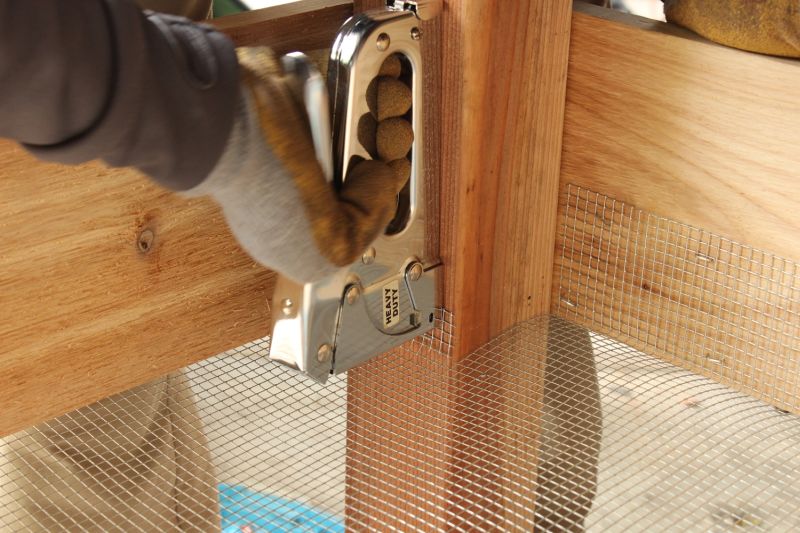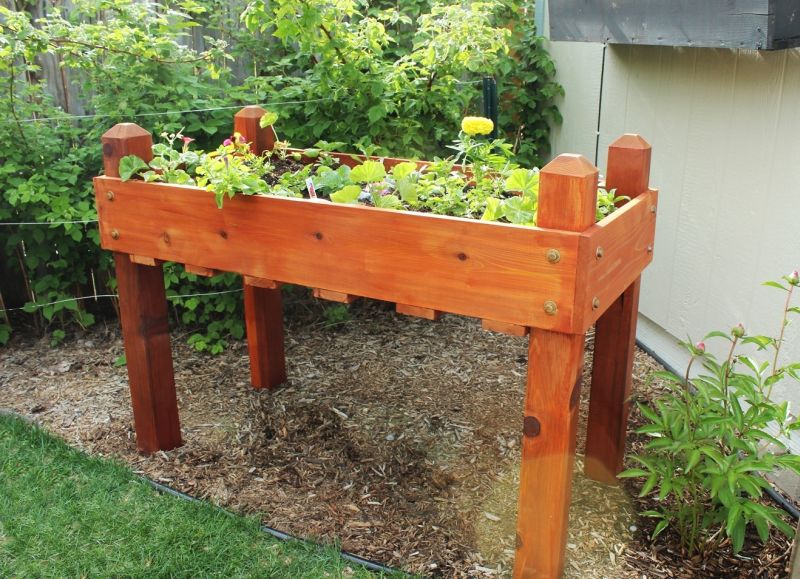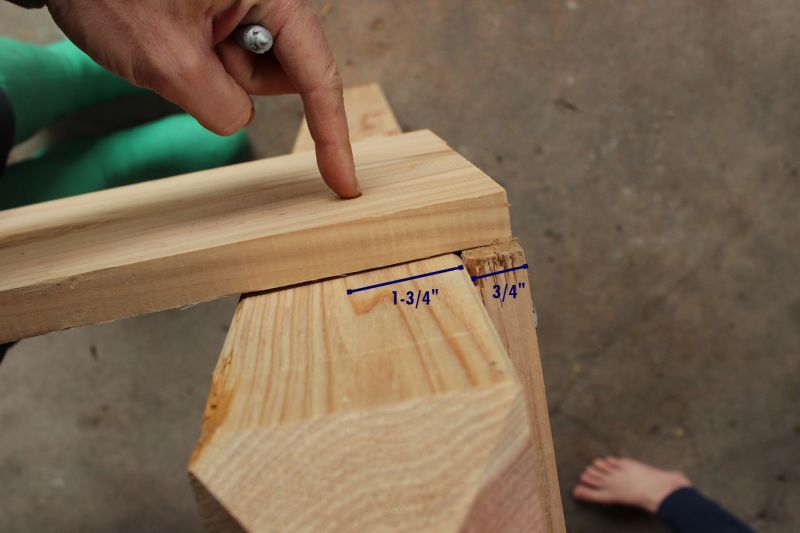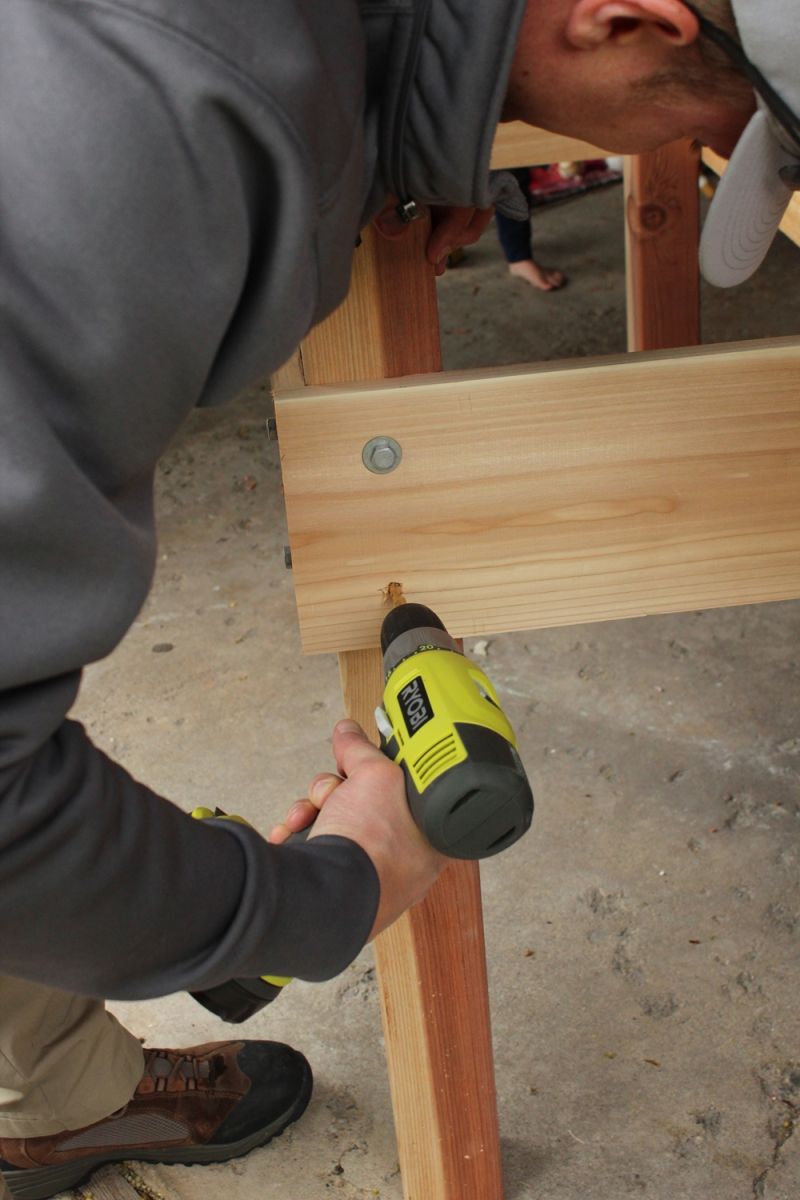With your hardware cloth stapled into place, you can more easily work with the inner portion, between the two posts.

What Grows Best in a Raised DIY Planter Box?
1-3/4” is a nice measurement here because a 4×4 post really measures in at 3-1/2”, so that makes the hex screws perfectly centered on the post.
Note: While you may be tempted to skip wearing gloves, you’ll want to protect your hands when cutting this material as it can easily scratch or injure you.


Foods That Do Best in a Planter:
- Basil
- Green Beans
- Peas
- Radishes
- Strawberries
- Tomatoes
- Potatoes
- Peppers
- Parsley
Flowers That Do Best in a Planter:
- Begonia
- Celosia
- Geraniums
- Impatiens
- Coleus
- Marigolds
- Petunia
- Salvia
- Creeping Phlox
- Zinnia
What Kind of Wood Should I Use for a DIY Raised Planter Box?

Although you want these next eight hex screws centered on the posts, you won’t be measuring in 1-3/4” from the sides of your boards because you have to factor in the 3/4″ width of the 4’ board that’s already attached to the post.
The best depth to aim for with a raised wooden planter box is eight to twelve inches. Keep this in mind as you build your raised planter box to ensure you can create the perfect depth for plants, flowers, and veggies!
Additionally, you need to consider the type of wood you build your planter box out of as well, as this will dictate how sturdy your planter box is, and ultimately, how long it will last.
Measure 1-3/4” in from the sides of your 1×8 boards, and 1-3/4” in from the top/bottom of the boards.
- Cedar
- Oak
- Redwood
Set your miter saw horizontally to cut 45 degrees, then line up the 1” points with the saw and make your cuts.
How Deep Should a Raised Planter Box Be?
If the ends of your hardware cloth are longer than you want, it might be easier (and less sharp) to simply fold them over and staple them.

Measure, then predrill the four holes on your other 2’ long 1×8 board.
Make an “X” to mark the precise points you’ll be predrilling for the hex screws.
We love how it brightens up a currently colorless corner of a f our yard. Of course, you could opt for even brighter blooms in your DIY raised planter box, which will soon make it a focal point in your garden.
You only need to keep enough to staple securely, about 2”.

There are a few exceptions to this however. Cabbage, for example, requires at least 10 inches of soil to flourish.
Why is Soil Depth Important?
If the ends of your hardware cloth are short enough (anything shorter than 4” is probably fine), go ahead and staple it to the 1×8 end boards.
Note: Make sure you fit this well to avoid any weeds from growing and damaging the plants you plan to add to your raised planter box.

How Do I Know If My Plants Are Cramped?
You want your wood to be in the best condition possible at this point in the process, to create the perfect raised planter box for your garden.
Again, mark your drilling points with an “X.”
This is what your box will look like at this point. Repeat all these steps for the other end of your box, so that you can flip your box back to upright and continue working on it that way.
What Do You Put in the Bottom of a Raised Wooden Planter Box?


When a raised planter box is on the tall or deep side, you may need to put some items in the bottom to get it at the right height to plant your plants.
You can also use pine to create a DIY raised planter box, but pine should only be used for planters that will be placed indoors.
- Crushed Aluminum Cans
- Plastic Milk Jugs
- Plastic Water Bottles
- Plastic Soda Bottles
- Empty Potting Soil Bags
- Plastic Garden Liner
- Rocks
- Pieces of Cement
Step-By-Step To Make DIY Raised Planter Boxes
Marking on both sides of the measuring tape gives you two points of reference for levelness.
Allow for at least 7” of additional length from the inside side of your 4×4 posts, then unroll the hardware cloth until it reaches the other two 4×4 posts.

Materials you’ll need to build the Raised Planter Box With Legs:

- One (1) 12’ 4×4 redwood post (or four posts cut to 3’ lengths)
- Two (2) 4’ 1×8 cedar planks
- Two (2) 2’ 1×8 cedar planks
- Six (6) 2’ 1×4 cedar planks
- 2’ wide 1/4″ grid hardware cloth (aka wire mesh)
- 24 (or more) 1-5/8” exterior screws
- 16 3/8” x 2” long hex screws and washers
- Staple gun, ratchet, sander/sandpaper, exterior wood stain
- Landscape fabric (aka weed barrier)
- Potting mix or soil + seeds/plants
Equipment Needed:
- Compound miter saw (aka “chop saw”)
- Power drill
Part 1: How to build the Raised Planter Box
Step 1: Measure the wood post
Ensure these are accurately measured on either side for best results.

Step 2: Cutting the wood
Repeat the process, on this second 2’ board, of attaching just the top two hex screws.


Besides just flowers for decoration, they can also be used to hold almost anything you can grow in a garden, including spices, fruits, and vegetables.
Measure the width of your planter box; it should be 2’ wide.
To build the DIY raised planter boxes, you’ll need to gather the following materials.
Step 3: Angle cutting
Let it dry, then move it to the place in your yard, balcony, or deck that you plan on using the raised planter box.
Run your extra hardware cloth up one of the 4×4 posts to determine where you should cut to work around the post.

When your 2’ boards have been predrilled, have a helper hold up the 4’ board attached to the posts.

Lightly sand all other edges and corners and surfaces as you want.
For reference: We had 1-5/8” handy so used those, but anything over 1-1/4” would probably be fine.
On your two 4’ long 1×8 boards, you’re going to mark two points; these are for the hex screws to attach the side boards to the 4×4 posts.


Wear gloves. It’s safer, easier, and more efficient.

Step 4: Measure and Mark the Posts
Match your saw blade to the outer cut points, and cut the other two opposite angles.
For best results you will want to use one of the following types of wood to build your planter box.

(2-1/2” = 1-3/4” [post center] + 3/4″ [other 1×8 actual width])

Line up the top edge of the 1×8 board with the 31” mark that you made on one of your posts. Use a drill bit of your choice (example uses a 1/4″ bit) and predrill the holes.



Tuck the box away between a backyard shed and some raspberry bushes. The mahogany flame hue looks fresh and bright in this setting.
Step 5: Drilling



Whether you want a flower box, an herb garden, or even a place to grow and harvest your very own vegetables, this DIY project allows you to do it – and as a raised box plan, it won’t kill your back to plant (and/or encourages the kids to garden alongside you).

Begin by measuring your 4×4 post into four equal lengths.
This stabilizes the structure, making it much easier to install all the bottom hex screws onto a solid structure with the boards accurately in place.
Mark on both sides of the measuring tape for each side.
Repeat for the other top hole, on the opposite side of this 2’ board.
Align one end of a 2’ board with your 31” height line (or with the 4’ board if you prefer; hopefully the alignments are one and the same), and drill a bit into the 4×4 post through the top predrilled hole.
Step 6: Attach the Boards
Only staple near the center of the planter box at this point, just enough to hold the hardware cloth in place while you work out the corners.

Predrill the posts for the bottom holes on your 2’ boards, then install the bottom four hex screws (two per board).
Take your 1/4″ hardware cloth (aka “wire mesh”) and get it ready to unroll.
Although these holes are further from the ends of the 2’ boards than the holes for the 4’ lengths, it is still highly recommended to predrill.

If your miter saw doesn’t rotate vertically for angle cutting measure 1” in from the sides of your post, right along the top edge.
Note: Cedar is prone to splitting, and this extra step doesn’t take much time but adds a lot of precision and protection from board split.
Fill your planter box about 2/3 full.


Step 7: Predrill the Board
Fold the ends of the hardware cloth over so that the ends are sandwiched between the rest of the hardware cloth and the side board.


Lay your 4×4 posts down and measure 31” from the bottom of each post on just two adjoining sides.
Step 8: Attach the Boards to the Posts
Push the hardware cloth down so the fold is even with what will be the bottom edge of your raised planter box.

What you’re marking is the point at which the top of your 1×8 side boards will be attached.
Once the flap is folded and in place on the inside of your planter box, staple the edges of your hardware cloth all the way up to the 4×4 post.
You have many options of what you can fill your planter with.
Not only that, but they also need to be properly spaced to allow them room to grow. Flowers with large bulbs need a soil depth of at least 14 inches.
Once both 4’ long 1×8 boards are attached to the posts, it’s time to attach the two 2’ long 1×8 boards.

Step 9: Repeat the Process on the Other Board
Although you’ve (hopefully) used outdoor-friendly wood, like cedar and fir, you’ll still do well to treat the wood to withstand the elements and last longer.

Make sure you distribute the soil evenly throughout the raised planter box, so there are no gaps or thinner areas.
Some ideas include:

Staple what’s left of the flaps securely to the posts or planter side boards.

When it comes to creating your DIY raised planter box, you will want to make sure that you build it out of quality wood.
Step 10: Flip Your Planter Box Over
Throw some vegetable seeds in there, plant a few flowers, section out some herb plots, whatever.
Throw a few staples from your staple gun to attach your hardware cloth to what will be the bottom edge of your 4’ long 1×8 sides.
Next, snip from the end of the hardware cloth along the corner of your post down until you reach the same horizontal point as your first snip (which should be even with what will be the bottom edge of your 1×8 board).
Step 11: Prepare the Hardware Cloth
Staple in place.
Place a washer then hex screw into each predrilled hole.
The number one way to know if your plant is experiencing cramped roots is if it starts to have chronically yellowing leaves, and leaves that are too small for the plant.

Repeat the process described above to complete cutting the tops of all four posts.
As you can see, a DIY raised planter box is an amazing addition to your home.

Because you don’t want massive amounts of extra hardware cloth poking out of your box, to rust, snag, or cause hurt, it’s time to trim.
Step 12: Secure the Hardware Cloth


At this point, you should have the top two hex screws holding the 2’ board in place while also connecting the posts into a three-sided structure.



We’ll start with the first folded flaps near the box post.
Step 13: Finish Off Installing the Hardware Cloth
Before you start building, you need to have a plan of how deep your raised planter box will be. Different plants will require different depths of soil in order to grow.
A DIY raised planter box can be an amazing addition to your garden.
Pro Tip: You can use the structure as a sort of saw horse, if you’d like. Just take care not to drill into any wood that’s already in use or attached.

If the soil in your planter is not deep enough, the plants will be unable to grow proper roots and will not flourish. Improper soil depth will leave you with underperforming plants or seeds that don’t sprout at all.
Carefully fold the newly cut corner “flap” downward along the post, into the inner portion of your planter box.
Remove any type of staple or alien material on the ends of your wood pieces.
Not only can it grow almost any plant you can think of, but the fact that you are building it yourself means that it will fit in perfectly into the aesthetic of your backyard.
Repeat for the other flap on this side of your box.
Predrill each 1×4 support board as it rests in place on the bottom of the 1x8s.
This will let you know how deep to make your planter box.
For reference: We used Australian timber oil in Mahogany Flame to stain and protect this planter box.
Carefully flip your planter box over so it’s resting on its post-tops.

Building a DIY raised planter box isn’t difficult, so there’s no reason to hesitate.

Step 14: Repeat the Steps on the Other End
This is because your planter will likely be spending most of its time outside, and it needs to be somewhat resistant to things like insects and the elements.

This is a wonderful addition to a backyard, a front yard, a side yard, or even a deck or balcony. The raised planter box design is easy on one’s back and just different enough from other flower beds or herb or vegetable gardens that it’s eye-catching and a treat to look at.


So prior to heading to the store to get construction supplies, take the time to make a list of all the plants you would like to grow in your planter, and double check the soil depth you need.
Step 15: Trim the Flaps on All Four Posts

You may also notice that your plant isn’t growing as prolifically as it did before, and that it is wilting.

Predrill just through the board at this point (as opposed to predrilling through the board and post together).

Learn to make a spring-ready DIY raised planter box with our quick, step-by-step guide. With just some handywork and time, you’ll have a beautiful space to watch your flowers bloom all season long.


Grab some exterior screws.
Unroll at least 7” more, then mark your cutting spot. Use wire cutters (aka “tin snips”) to cut the hardware cloth.

Step 16: Installing the Cedar Boards for Support
So your side markings for your 2’ long 1×8 cedar boards will be 1-3/4” from the top/bottom of your board (same as the 4’ lengths) but 2-1/2” in from the sides.
The post DIY Raised Planter Box – A Step-by-Step Building Guide appeared first on Homedit.
Grab a big bag of potting mix or soil of your choice.
The hardware cloth will be sandwiched between these two boards.
Do you think that there might be too many plants in your DIY planter? Or perhaps your plants don’t have sufficient root space in your raised planter box?

Do two opposite sides first, then rotate your post 90 degrees.

Sand any obvious rough spots, such as the ends of your 1×4 boards.
Fold it so it will tuck up inside the planter box.

Step 17: Sand Down Any Rough Spots

When the hardware cloth is completely secured and in place, it’s time to support it with some 1×4 cedar boards.

Tighten up the hex screws with a ratchet until they’re pretty tight. Don’t overtighten that the cedar board splits, however. That’s counterproductive. The last thing you want is to ruin your precious work at this point, or you’ll be back to square one. Take your time throughout the process and don’t rush any stage to ensure you create a high-quality DIY raised planter box.

Begin with a short snip in from the side, up to the corner of your post.
Part 2: Finishing the design
Step 1: Treat the Wood
Cut, fold, and staple breathable landscape fabric (aka “weed barrier”) to the inside of your planter box.
Simply measure and mark 1” lines from what will be the top ends of each of your 4×4 posts. Set your miter saw at a 45” angle, and make four cuts to each post, rotating the post 90 degrees (to a new side) after each cut.
Attach the washer and hex screw into this predrilled hole with a ratchet.
These beautiful wooden raised planter boxes with legs can last 10-20 years if maintained!
Step 2: Add Breathable Landscape Fabric

Generally, most plants will flourish in 6 to 8 inches of soil.

Use your miter saw to cut the post into four equal 3’ lengths.
Step 3: Add Potting Mix or Soil
First, make sure that the bottom of raised planter box is deep enough to add flowers, and vegetables. Once that’s set, you can add seeds or plants directly into the planter box itself. As the seasons change, your plants will grow beautifully and strong!
This adds a nice finishing touch to the post-tops, which will be visible with this raised planter box plan design.
To ensure that your planter box has longevity, make sure to install a liner. This will help prevent rot from occurring.
Repeat the process with your other pieces of wood so that you end up with two 4’ lengths of 1×8, two 2’ lengths of 1×8, and six 2’ lengths of 1×4.
The whole reason you are building a planter is to grow some beautiful flowers and tasty veggies.
Step 4: The Final Step – Add Flowers, Herbs, or Plants to Your Raised Planter Box

At this point, the raised planter box is yours to do with what you want.



Flip your planter box over to rest on its post-tops. Lay out your six 1×4 boards evenly.
A DIY raised planter box is ideal for anyone who is short of space in their garden or doesn’t have the space to plant anything on the ground. You could even add this to a large balcony in an apartment. If you do have a larger garden, consider making multiple raised planter boxes by repeating our guide here today.
Frequently Asked Questions (FAQ)FAQ
How deep should should a raised planter box be?
Trim the flap to about 2” high, and throw the rest away. Repeat for the flaps on all four posts.
How to plant in raised planter boxes?
Head over to your local hardware store and start building your DIY planter today so you can have the garden of your dreams!
How do I keep my planter box from rotting?

How long do planter boxes last?
Repeat for the other post on this end of the planter box so that you can flatten the inner part of the hardware cloth, between the two posts.
Raised planter box: Final Thoughts

The hex screws that attach these two 1x8s shouldn’t hit the other hex screws.
Note: You can make sure of this by holding up a 2’ board next to the post, and holding up the hex screw as well.
Bend the thin portion of the flap so that it touches the side board.
Screw in your screws to the predrilled holes.